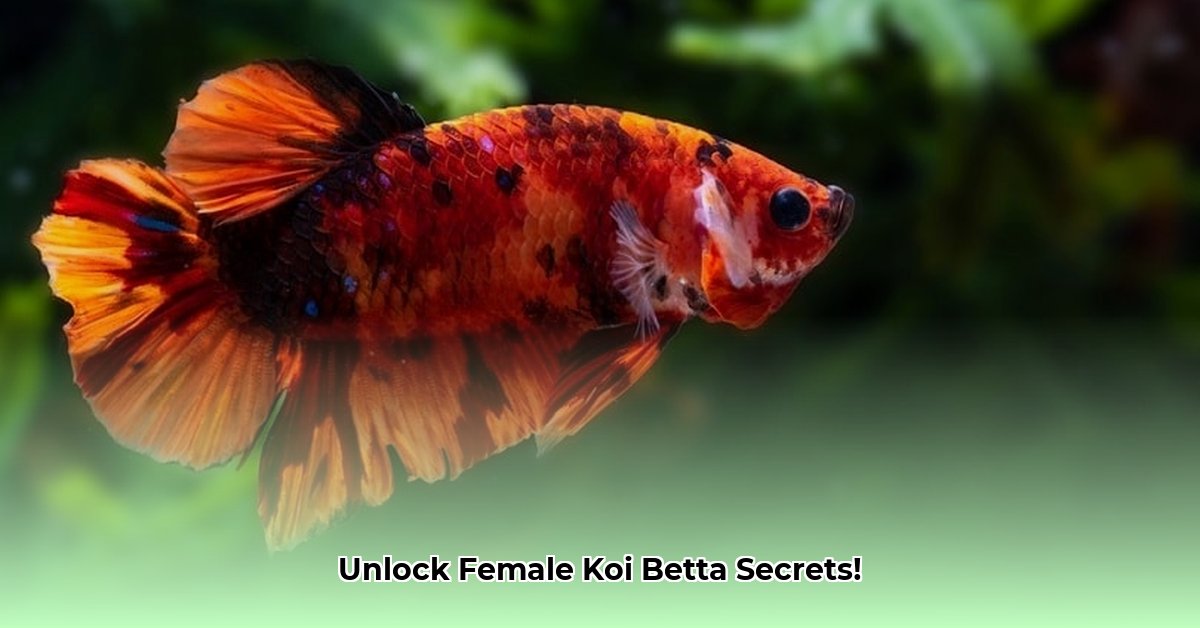Thinking about adding a female Koi Betta to your aquarium? Awesome! This guide is packed with key information for keeping these beauties happy and healthy, no matter your experience level. We’ll cover everything from setting up their perfect habitat to understanding their unique behaviors, ensuring your finned friend thrives.
What Makes Female Koi Bettas Special?
Koi Bettas aren’t just any fish; they’re living works of art. Their name comes from their resemblance to Koi carp, boasting vibrant, marbled patterns that make each one unique. As members of the Betta splendens species, they share the same basic needs as other Bettas, but understanding their specific requirements is vital for their well-being.
Creating the Ideal Habitat: Tank Size and Setup
A happy Betta starts with the right home. For a single female Koi Betta, a 5-gallon tank is a good starting point, but bigger is always better! If you’re considering a sorority (a group of females), a 20-gallon tank or larger is essential to minimize aggression and provide ample space for each fish to establish their own territory.
Essential elements for a thriving Betta tank:
- Gentle Filter: Bettas don’t like strong currents, so opt for a sponge filter or one with an adjustable flow.
- Heater: Maintain a consistent water temperature between 76-82°F (24-28°C).
- Hiding Places: Provide plenty of caves, driftwood, and plants (live or silk) to reduce stress and create a sense of security.
- Lid: Bettas are known to jump, so a secure lid is a must to prevent escapes.
- Substrate: Sand or fine gravel is gentle on their delicate fins.
Water Quality: the Key to a Healthy Betta
Clean water is non-negotiable for Betta health. Regular water changes (25-50% weekly) are crucial for removing waste and maintaining optimal water parameters.
- Ammonia and Nitrite: Should always be at 0 ppm (parts per million).
- Nitrate: Keep below 20 ppm.
- pH: Aim for a range of 6.5-7.5.
A reliable water testing kit is an invaluable tool for monitoring these parameters. Some keepers also add Indian Almond Leaves to the tank, which release tannins that can help reduce stress and promote a healthy environment.
Feeding Your Female Koi Betta: A Balanced Diet
Koi Bettas are carnivores, so their diet should be high in protein.
- Betta Pellets: High-quality betta pellets should form the foundation of their diet.
- Live or Frozen Foods: Supplement with live or frozen bloodworms, brine shrimp, or daphnia a few times a week for added variety and nutrition.
Feed small portions (what they can consume in 2-3 minutes) once or twice a day to avoid overfeeding and water quality issues.
Understanding Betta Behavior: Solitary or Social?
Female Koi Bettas can thrive in a solitary setting or in a sorority, but each option requires a different approach.
- Solitary Females: Generally peaceful and content on their own, a single female can flourish in a well-maintained tank.
- Sororities: Keeping multiple females together can be rewarding, but it requires careful planning and monitoring. Introduce all females simultaneously to a large, well-planted tank to minimize aggression. Watch closely for signs of bullying, and be prepared to separate any persistently aggressive individuals.
Breeding Koi Bettas: A Challenging but Rewarding Endeavor
Breeding Koi Bettas is not for the faint of heart, but it can be a fascinating experience. It requires a dedicated setup, a thorough understanding of genetics, and a commitment to raising the fry.
- Selective Breeding: To maintain the desired Koi coloration, you’ll need to carefully select breeding pairs that exhibit the traits you want to pass on.
- Breeding Tank: A separate breeding tank with shallow water, a heater, and gentle filtration is essential.
- Fry Care: Once the fry hatch, they’ll need specialized food and meticulous water changes to ensure their survival.
Troubleshooting Common Problems: A Quick Guide
Even with the best care, problems can sometimes arise. Here’s a handy troubleshooting guide:
| Problem | Possible Cause(s) | Solution |
|---|---|---|
| Lethargy/Loss of Appetite | Poor water quality, illness, stress | Test water, improve water quality, observe for other symptoms, consider medication. |
| Fin Rot | Poor water quality, injury, bacterial infection | Improve water quality, treat with antibacterial medication. |
| Aggression (in Sorority) | Overcrowding, lack of hiding places | Increase tank size, add more plants and decorations, separate aggressive individuals. |
| Jumping Out | Stress, poor water quality | Ensure a secure lid, address underlying stress factors. |
Advanced Tips for Thriving Female Koi Bettas
- Enrichment: Provide your Betta with mental stimulation by rearranging decorations or adding new toys to the tank.
- Observation: Pay close attention to your Betta’s behavior and appearance, as this can be an early indicator of health problems.
- Quarantine: Always quarantine new fish for 2-4 weeks before introducing them to your main tank to prevent the spread of disease.
Caring for female Koi Bettas is a rewarding experience that brings beauty and tranquility to your home. By understanding their needs and providing them with a proper environment, you can enjoy the companionship of these amazing fish for years to come.
- Gluten Free Meal Prep Ideas for Delicious, Hassle-Free Eating - November 28, 2025
- Gluten Free Meal Prep for Stress-Free and Healthy Eating - November 27, 2025
- Quick And Easy Chicken Thigh Meal Prep For Weight Loss - November 26, 2025










